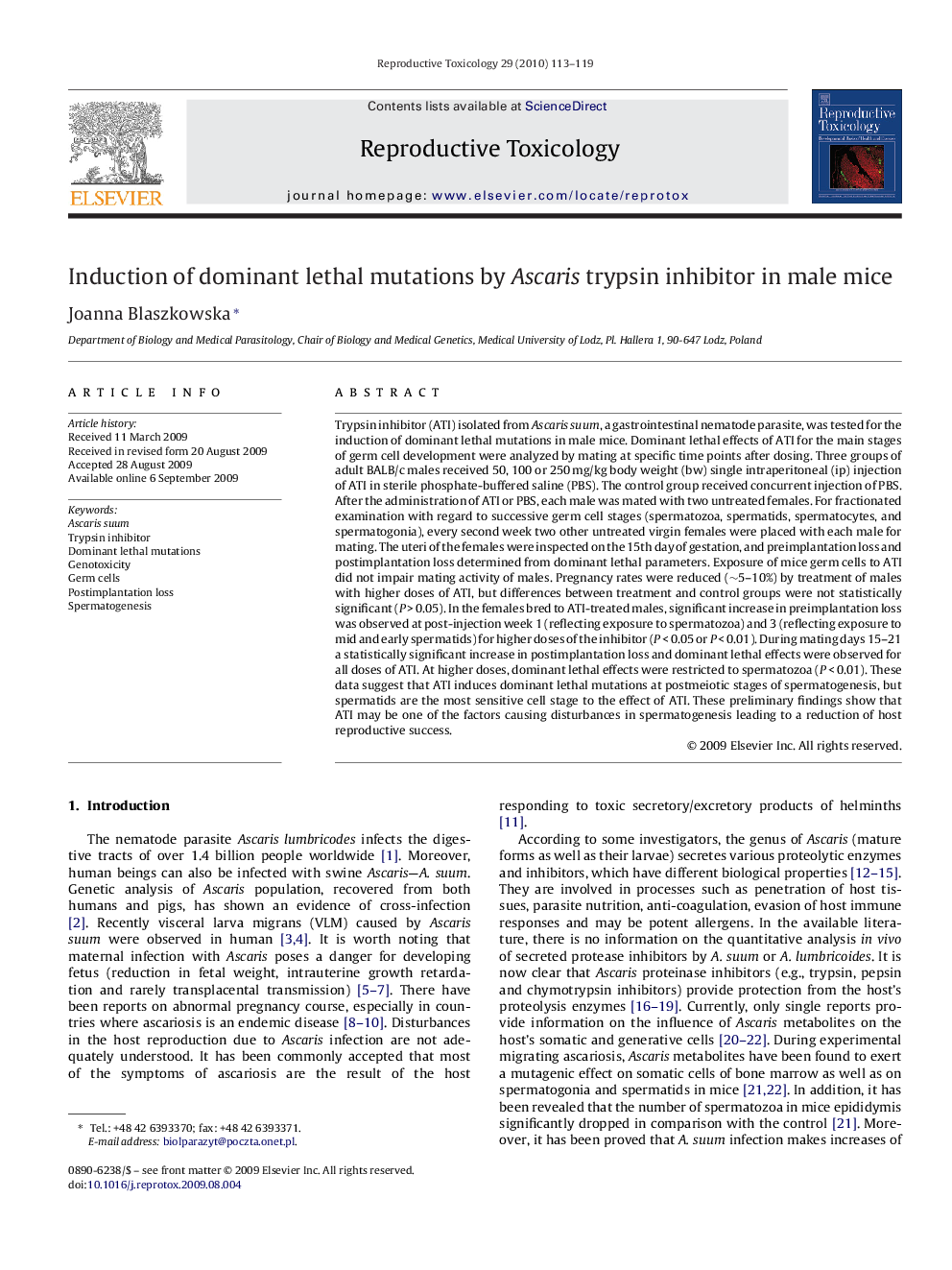| کد مقاله | کد نشریه | سال انتشار | مقاله انگلیسی | نسخه تمام متن |
|---|---|---|---|---|
| 2594606 | 1132274 | 2010 | 7 صفحه PDF | دانلود رایگان |
عنوان انگلیسی مقاله ISI
Induction of dominant lethal mutations by Ascaris trypsin inhibitor in male mice
دانلود مقاله + سفارش ترجمه
دانلود مقاله ISI انگلیسی
رایگان برای ایرانیان
کلمات کلیدی
موضوعات مرتبط
علوم زیستی و بیوفناوری
علوم محیط زیست
بهداشت، سم شناسی و جهش زایی
پیش نمایش صفحه اول مقاله

چکیده انگلیسی
Trypsin inhibitor (ATI) isolated from Ascaris suum, a gastrointestinal nematode parasite, was tested for the induction of dominant lethal mutations in male mice. Dominant lethal effects of ATI for the main stages of germ cell development were analyzed by mating at specific time points after dosing. Three groups of adult BALB/c males received 50, 100 or 250Â mg/kg body weight (bw) single intraperitoneal (ip) injection of ATI in sterile phosphate-buffered saline (PBS). The control group received concurrent injection of PBS. After the administration of ATI or PBS, each male was mated with two untreated females. For fractionated examination with regard to successive germ cell stages (spermatozoa, spermatids, spermatocytes, and spermatogonia), every second week two other untreated virgin females were placed with each male for mating. The uteri of the females were inspected on the 15th day of gestation, and preimplantation loss and postimplantation loss determined from dominant lethal parameters. Exposure of mice germ cells to ATI did not impair mating activity of males. Pregnancy rates were reduced (â¼5-10%) by treatment of males with higher doses of ATI, but differences between treatment and control groups were not statistically significant (PÂ >Â 0.05). In the females bred to ATI-treated males, significant increase in preimplantation loss was observed at post-injection week 1 (reflecting exposure to spermatozoa) and 3 (reflecting exposure to mid and early spermatids) for higher doses of the inhibitor (PÂ <Â 0.05 or PÂ <Â 0.01). During mating days 15-21 a statistically significant increase in postimplantation loss and dominant lethal effects were observed for all doses of ATI. At higher doses, dominant lethal effects were restricted to spermatozoa (PÂ <Â 0.01). These data suggest that ATI induces dominant lethal mutations at postmeiotic stages of spermatogenesis, but spermatids are the most sensitive cell stage to the effect of ATI. These preliminary findings show that ATI may be one of the factors causing disturbances in spermatogenesis leading to a reduction of host reproductive success.
ناشر
Database: Elsevier - ScienceDirect (ساینس دایرکت)
Journal: Reproductive Toxicology - Volume 29, Issue 1, January 2010, Pages 113-119
Journal: Reproductive Toxicology - Volume 29, Issue 1, January 2010, Pages 113-119
نویسندگان
Joanna Blaszkowska,